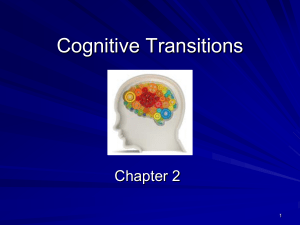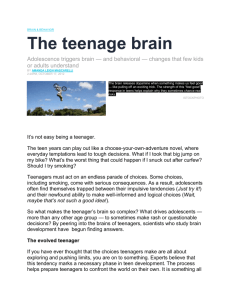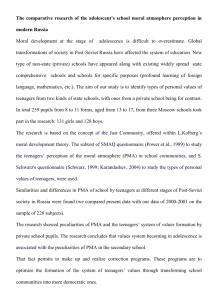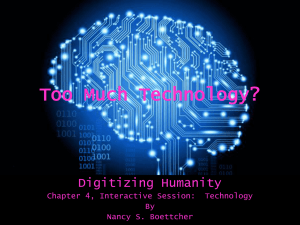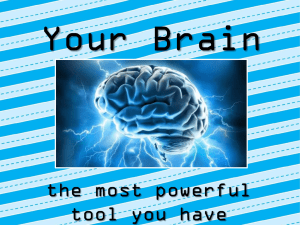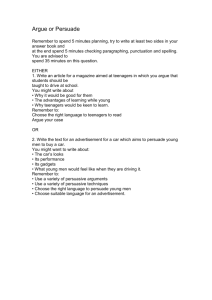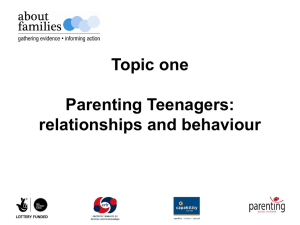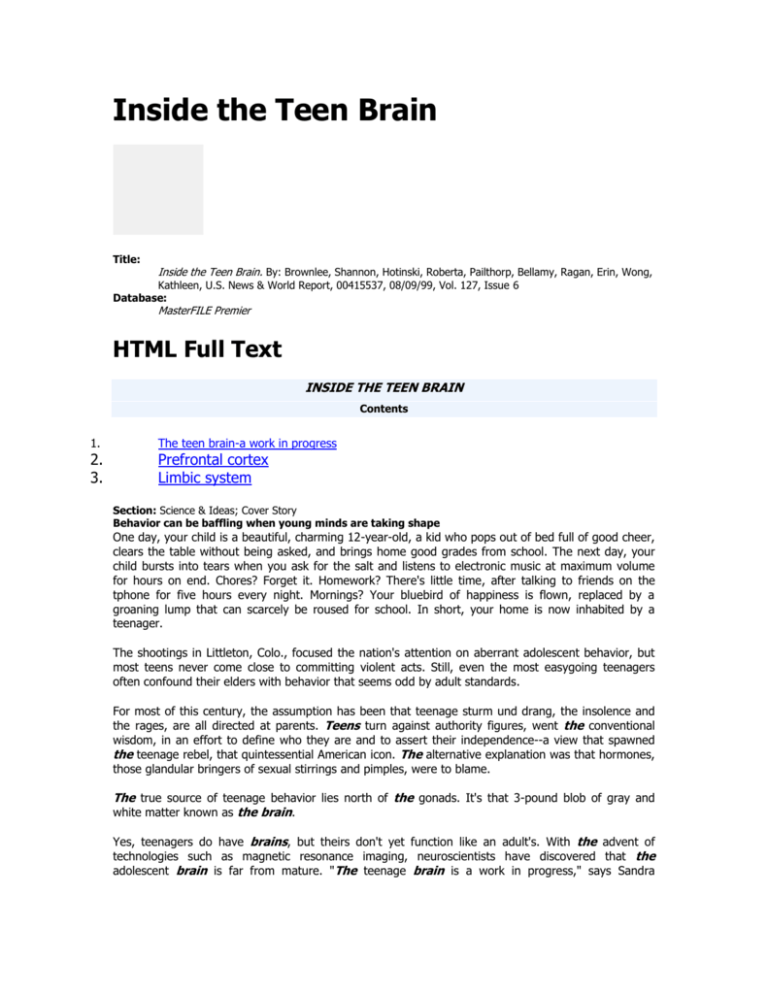
Inside the Teen Brain
Title:
Inside the Teen Brain. By: Brownlee, Shannon, Hotinski, Roberta, Pailthorp, Bellamy, Ragan, Erin, Wong,
Kathleen, U.S. News & World Report, 00415537, 08/09/99, Vol. 127, Issue 6
Database:
MasterFILE Premier
HTML Full Text
INSIDE THE TEEN BRAIN
Contents
1.
2.
3.
The teen brain-a work in progress
Prefrontal cortex
Limbic system
Section: Science & Ideas; Cover Story
Behavior can be baffling when young minds are taking shape
One day, your child is a beautiful, charming 12-year-old, a kid who pops out of bed full of good cheer,
clears the table without being asked, and brings home good grades from school. The next day, your
child bursts into tears when you ask for the salt and listens to electronic music at maximum volume
for hours on end. Chores? Forget it. Homework? There's little time, after talking to friends on the
tphone for five hours every night. Mornings? Your bluebird of happiness is flown, replaced by a
groaning lump that can scarcely be roused for school. In short, your home is now inhabited by a
teenager.
The shootings in Littleton, Colo., focused the nation's attention on aberrant adolescent behavior, but
most teens never come close to committing violent acts. Still, even the most easygoing teenagers
often confound their elders with behavior that seems odd by adult standards.
For most of this century, the assumption has been that teenage sturm und drang, the insolence and
the rages, are all directed at parents. Teens turn against authority figures, went the conventional
wisdom, in an effort to define who they are and to assert their independence--a view that spawned
the teenage rebel, that quintessential American icon. The alternative explanation was that hormones,
those glandular bringers of sexual stirrings and pimples, were to blame.
The true source of teenage behavior lies north of the gonads. It's that 3-pound blob of gray and
white matter known as the brain.
Yes, teenagers do have brains, but theirs don't yet function like an adult's. With the advent of
technologies such as magnetic resonance imaging, neuroscientists have discovered that the
adolescent brain is far from mature. "The teenage brain is a work in progress," says Sandra
Witelson, a neuroscientist at McMaster University in Ontario, and it's a work that develops in fits and
starts.
Until the past decade, neuroscientists believed that the brain was fully developed by the time a child
reached puberty and that the 100 billion neurons, or nerves, inside an adult's skull--the hardware of
the brain--were already in place by the time pimples began to sprout. The supposition was that a
teenager could think like an adult if only he or she would cram in the necessary software--a little
algebra here, some Civil War history there, capped by proficiency in balancing a checkbook. But the
neural circuitry, or hardware, it turns out, isn't completely installed in most people until their early 20s.
And just as a teenager is all legs one day and all nose and ears the next, different regions of his
brain are developing on different timetables. For instance, one of the last parts to mature is in
charge of making sound judgments and calming unruly emotions. And the emotional centers in the
teenage brain have already been revving up, probably under the influence of sex hormones.
This imbalance may explain why your intelligent 16-year-old doesn't think twice about getting into a
car driven by a friend who is drunk, or why your formerly equable 13-year-old can be hugging you one
minute and then flying off the handle the next.
Indeed, the brain inside a teenager's skull is in some ways closer to a child's brain than to an
adult's. Still being forged are the connections between neurons that affect not only emotional skills
but also physical and mental abilities. That means that it might be unreasonable to expect young
teenagers to organize multiple tasks or grasp abstract ideas. And these still-developing neural links
leave a teenager vulnerable: Depression in adolescence may set up circuits in the brain that will
make it much harder to treat the illness later in life.
But these changes aren't all for the worse. The brain's capacity for growth through adolescence may
also indicate that even troubled teenagers can still learn restraint, judgment, and empathy.
"Adolescence is a time of tumultuous change in the brain," says Jay Giedd, a child psychiatrist at the
National Institute of Mental Health in Bethesda, Md. "Teenagers are choosing what their brains are
going to be good at--learning right from wrong, responsibility or impulsiveness, thinking or video
games."
If there's one thing that drives parents nuts about their teenagers, it's moodiness. "It's hot and cold,
nasty and nice," says Vicki Sasso, 34, the mother of 13-year-old Angelo, a ninth grader from Staten
Island, N.Y. "One minute loving me, one minute hating me." Don't blame Angelo; blame the parts of
his brain that process emotions and make decisions. His prefrontal cortex, where judgments are
formed, is practically asleep at the wheel. At the same time, his limbic system, where raw emotions
such as anger are generated, is entering a stage of development in which it goes into hyperdrive.
Brain police. The limbic system, located deep in the brain's interior, is associated with gut reactions,
sparking instant waves of fear at the sight of a large snake or elation at a high SAT score. In adults,
such emotional responses are modulated by the prefrontal cortex, the part of the brain that lies just
behind the forehead and that acts as a sort of mental traffic cop, keeping tabs on many other parts of
the brain, including the limbic system.
Indeed, the brain works something like a loosely organized team, with various parts carrying out
different tasks and more or less cooperating with one another. The prefrontal cortex, says Karl
Pribram, director of the Center for Brain Research and Informational Sciences at Radford University
in Virginia, is in charge of "executive functions."
These include the brain's ability to handle ambiguous information and make decisions, to coordinate
signals in different regions of the brain, and to tamp down or prolong emotions generated in the
limbic system. In an adult, for instance, an overheard insult might arouse a murderous rage, until the
prefrontal cortex figures out that the comment was meant for somebody else and tells the limbic
system to pipe down. As Pribram puts it, "The prefrontal cortex is the seat of civilization."
Something very different happens in teenagers, according to Deborah Yurgelun-Todd, a
neuropsychologist at McLean Hospital in Belmont, Mass. In recent experiments, Yurgelun-Todd and
graduate student Abigail Baird showed adults and teenagers photographs of people's faces contorted
in fear. When the researcher asked her subjects to identify the emotion being expressed, all of the
adults got it right. Many of the teens, however, were unable to correctly identify the expression.
Then the researchers used functional magnetic resonance imaging, a technology that takes a picture
of brain activity every three seconds or so in order to see which parts are being used during
processing. Adult brains, the scientists discovered, light up in both the limbic areas and the
prefrontal cortex when looking at expressions of fright. In teenagers, however, the prefrontal cortex
was almost dark while the limbic system lit up.
These results suggest to Yurgelun-Todd that kids may not be as good as we think they are at
interpreting facial expressions, in part because the prefrontal cortex is not yet lending the limbic
system a hand. Teenagers are not adept readers of social signals, such as facial expressions, even if
they seem to do nothing but socialize. "You have to actually learn how to read emotions," says
Yurgelun-Todd. "We may think anger is pretty obvious to our kids, but they may not."
Map makers. Yurgelun-Todd's research reinforces other new findings suggesting that the average
teenager's prefrontal cortex isn't ready to take on the role of brain CEO. At NIMH, Giedd and
colleagues are using another type of MRI, which captures brain structure rather than activity, to chart
for the first time normal brain development from childhood through adolescence.
Since 1991, Giedd and his colleagues have mapped the brains of nearly 1,000 healthy children and
adolescents ranging in age from 3 to 18. Each child must lie inside a claustrophobically narrow tube
surrounded by the giant, humming machine, holding perfectly still for 10 minutes at a stretch while a
computerized brain image is built.
The researchers expected to find that after puberty, the brain looks like an adult's. Instead, they
found that the prefrontal cortex undergoes a growth spurt at around age 9 or 10, when neurons
begin sprouting new connections, or synapses. Most of these connections subsequently die off,
starting at about age 12, in a process called pruning--a sort of "use it or lose it" system for ensuring
that the brain nourishes only the neurons and synapses that are useful. Pruning, which occurs in
different parts of the brain at different times, also appears to allow the brain to think more
efficiently.
Until the prefrontal cortex has been pruned, most young teenagers don't yet have all the brain
power they need to make good judgments. Researchers suspect that the excess of synapses means
the young adolescent mind can't easily keep track of multiple thoughts, and it can't gain instant
access to critical memories and emotions that allow grown-ups to make judicious decisions.
"Good judgment is learned, but you can't learn it if you don't have the necessary hardware," says
Yurgelun-Todd. An unfinished prefrontal cortex also means that young teenagers may also have
trouble organizing several tasks, deciding, for example, which to do first: call a friend, wash the
dishes, or read the book for a report that's due in the morning.
The teenage tendency to leap before looking is compounded by the fact that adolescence is a time
for seeking out new experiences, including some that are dangerous. "I think all people do stupid
things sometimes. It just seems like teenagers do it more often," says Rachael Fisher, an 18-year-old
senior from Lakewood, Colo. That's an understatement. Driving without a seat belt, getting tattooed,
smoking cigarettes, shoplifting--the list of foolish things kids do is longer than most parents really
want to know.
Parents can relax a little, says Lynn Ponton, a child psychiatrist at the University of California-San
Francisco and author of The Romance of Risk. "Risk taking is normal." But not all of it, she adds, is
safe. Other research suggests that about 60 percent of a teenager's tendency to act impulsively and
misjudge potential danger is genetic, a trait that is shared with other family members and is probably
the result of differences in brain chemicals among individuals.
Mental mosh pit. Researchers also think that new experiences, especially those with a frisson of
danger or the thrill of the new, tap into a teenager's so-called reward system, a set of neurons that
link emotional centers to many other parts of the brain and that can produce feelings of intense
pleasure. This is the same set of neurons affected by certain illicit drugs, such as cocaine, that release
dopamine, one of the brain chemicals, or neurotransmitters, that are responsible for arousal and
motivation.
Marvin Zuckerman, a professor of psychology at the University of Delaware, and others suspect that
thrills--like sneaking out at night or jumping into the mosh pit at a heavy-metal concert--stimulate the
teenage brain's dopamine system, for reasons that are not yet fully understood. The result, however,
is clear: Teenagers are far more interested in novelty than children or adults are, probably because it
makes them feel good. Other research has shown that at the same time, levels of another
neurotransmitter, serotonin, appear to decline temporarily in most adolescents, making them more
likely to act impulsively.
Added to this brew of neurotransmitters are the sex hormones, which not only turn on an interest in
sex but also change the brain's architecture. Giedd and his colleagues recently reported for the first
time that, in both sexes, surges of testosterone at puberty swell the amygdala, an almond-shaped
part of the limbic system that generates feelings of fear and anger. (Girls' bodies make testosterone
by breaking down estrogen, while boys' bodies transform testosterone into an estrogen-like hormone
called estradiol.) This blossoming of the amygdala is especially pronounced in boys, but it may
account for the rise in aggressiveness and irritability seen in both sexes at adolescence. Increased
levels of estrogen at puberty are responsible for the sudden growth of the hippocampus, the part of
the brain that processes memory. The larger the hippocampus, the better the memory, at least in
animals. The hippocampus in girls grows proportionally larger than it does in boys, a finding that may
help explain why women are better than men are at remembering complex social relationships and are
likely to suffer less from the memory loss that accompanies Alzheimer's.
Estrogen and testosterone may not alter the brain at puberty so much as flip neurological switches,
which were set by hormonal levels while a child was still in his mother's womb. Once flipped, these
switches have a profound effect on a teenager's sex drive and moodiness.
Shifts in prenatal hormones also affect mental skills in ways that may not become apparent until later
in life. Testosterone, for example, appears to shape centers in the brain that process spatial
information. Evidence for this comes from a study of girls with congenital adrenal hyperplasia, or CAH,
a condition that causes their adrenal glands to pump out excess androgen, a testosterone-like
hormone, during prenatal development. Once the girls are born, they are given cortisone, to keep the
body from producing too much androgen.
Their brains, however, have already been molded. Sheri Berenbaum, a psychologist at Southern
Illinois University medical school, and others have found that as teenagers, girls with CAH report they
are more aggressive than their sisters, and they have better spatial skills--the ability to rotate an
object in their minds, for instance, or to imagine how pieces of a shape fit together. They are also
more interested than their sisters in becoming engineers and pilots, traditionally masculine
professions. But researchers don't yet know precisely how testosterone molds the brain's ability to
imagine all the facets of an object, or why it would make girls (or boys, for that matter) want to
become engineers.
One of the last steps in making an adult brain is the coating of nerves in white matter, fatty cells
that spiral around the shaft of nerves like vines around a tree. The white matter, also known as
myelin, acts like the insulation on an electric cord, allowing electrical impulses to travel down a nerve
faster and more efficiently. This is one reason a toddler is less coordinated than a 10-year-old. It now
appears that many of the nerves connecting different processing centers in the brain don't finish
myelinating until the early 20s.
Some of the nerves that become sheathed during adolescence connect areas of the brain that
regulate emotion, judgment, and impulse control. Francine Benes, a neuroscientist at McLean Hospital,
says that these nerves myelinate in girls earlier than in boys, which may help explain why teenage
girls seem more emotionally mature than boys, whose myelin levels may not equal girls' until age 30.
The myelination process also has been implicated in schizophrenia, which often becomes apparent in
late adolescence. Benes believes the faster transmissions overload defective nerves in schizophrenics.
"If the circuit starts to have too much information coming in too rapidly, it may become
overwhelmed."
Laying foundations. Researchers feel they have only begun to probe the workings of the adolescent
brain, but their findings already offer some new ways for parents to deal with teenagers. During
adolescence, many higher mental skills will become automatic, just the way playing tennis and driving
do. Kids who exercise their brains, in effect, by learning to marshal their thoughts, to measure their
impulses, and to understand abstract concepts, are laying the neural foundations that will serve them
for the rest of their lives.
"This argues for doing a lot of things as a teenager," says the NIMH's Giedd. "You are hard-wiring
your brain in adolescence. Do you want to hard-wire it for sports and playing music and doing
mathematics--or for lying on the couch in front of the television?" This hard-wiring also provides yet
another reason for teens not to take drugs or alcohol, because they may permanently alter the
balance of chemicals in their brains.
Parents can take comfort in knowing that searching for new experiences is a normal part of growing
up. The trick, say experts, is helping kids find healthy sources of stimulation. For one child, being in
the school play or volunteering in the community may provide plenty of excitement. For another, it
could take hang-gliding lessons. The problem, of course, is that safe risks are not always available to
the kids who need them. "Middle-class kids can go skiing and scuba diving," says the University of
Delaware's Zuckerman. "But for many kids, there's just crime, sex, drugs, and rock-and-roll."
The best news for parents is that the vast majority of kids will make it through adolescence with few
permanent scars, except perhaps the occasional hole through a bellybutton. New research shows that
most children emerge from adolescence physically and emotionally intact--although their parents will
probably never be the same. Mary Scott, 48, of Port Jefferson, N.Y., is a veteran of teenage wars:
She's the mother of two adolescents and a 22-year-old. "Occasionally they do things that are so
incredibly selfish, it's unbelievable," she says. On the other hand, Scott adds, "If they didn't drive you
crazy, they'd never leave [the nest]." Maybe adolescence is nature's way of forcing children to grow
up.
The teen brain-a work in progress
Researchers once thought that brain development was complete by puberty. Now they know that it
continues during the teenage years.
Prefrontal cortex
This area acts as the brain's traffic cop, coordinating processing among its competent parts and
modulating emotional responses. In teens, the prefrontal cortex isn't yet equipped to control
emotions and make good judgments.
Limbic system
This ring-shaped area deep within the brain generates primal emotions such as fear and rage. During
puberty surging hormones cause the amygdala to swell, particularly in boys. This may intensify
aggression.
DIAGRAM: The teen brain--a work in progress
PHOTO (COLOR): Sweet 16, and a birthday party becomes a time to experiment with new social roles
and relationships.
PHOTOS (COLOR): How does it feel? Teenage impulsiveness is partly explained by brain chemistry.
Members of Stereophonic practice in a rec room in Arlington, Va. Andrew, 16, grinds a rail near
Arlington's Yorktown High School. Amy, 16, scrawls on her arm during history class in San Jose, Calif.
PHOTOS (COLOR): Reaching out. In adolescence, the emotion rules, be it exhilaration or tumult.
Julie, 14, shows a dance move to David, 18, at Lincoln High School in San Jose. At Lincoln, Megan, 16,
comforts Brandi, 17, whose mother is in the hospital.
PHOTOS (COLOR): Pushing the envelope. Identity becomes a question, an obsession, and the punchline of a joke. Amber, 16, watches while her friend Sheena, 15, experiments with cleavage in a San
Jose department-store dressing room. Seniors on the Lincoln football team cheer the girls during a
powder-puff football game.
~~~~~~~~
By Shannon Brownlee
With Roberta Hotinski; Bellamy Pailthorp; Erin Ragan; Kathleen Wong
Take a teen-brain quiz online at http://www.usnews.com
Missed signals
YOU WERE ANGRY?
When grown-ups and teens don't see eye to eye, the problem might be in the brain.
Neuropsychologists studying brain development showed standardized pictures of fearful faces to 15
adults and 15 teenagers. All the adults correctly identified the emotion, but 11 of the teens guessed
wrong at least once, picking emotions such as anger or discomfort instead. The researchers, at
McLean Hospital in Belmont, Mass., say teenagers relied more on the primitive emotion center of the
brain and less on the region tied to judgment than adults did. Teens literally think differently than
adults, so their baffling behavior may reflect cluelessness, not stubborness.
ILLUSTRATION
~~~~~~~~
By Roberta Hotinski
Obsessed with food
ANOREXIA'S ROOTS IN THE BRAIN
It began innocently enough with an hour a day of exercising to a Jane Fonda workout tape, but once
Wendy Headrick began losing weight in eighth grade, she could not stop. Soon she quit eating candy,
then fat and meat. By the end of the year, she says, "I was drinking water, eating cucumbers and
other vegetables, and chewing gum to curb my appetite." Within 18 months, the 5-foot, 6-inch teen
had dropped from 145 to 84 pounds.
Headrick had anorexia nervosa, the eating disorder that afflicts millions of American teenagers, most
of them girls. Once thought to be entirely the result of cultural pressures on girls to be thin, anorexia
and bulimia (also an eating disorder) are now thought to be related as well to changes in the brain
that occur at puberty.
Headrick says the idea to lose weight occurred to her at age 13, when neighborhood children began
teasing her for being overweight. Most pubescent girls find themselves gaining weight suddenly
because their bodies must have a certain percentage of fat in order to mature sexually, says Sarah
Leibowitz, a neurobiologist at Rockefeller University in Manhattan. As a girl enters puberty, her
hypothalamus, a part of the brain that controls basic functions like sex and eating, starts churning
out high levels of a neurochemical that stimulates appetite.
Obsessed. While all girls put on fat at puberty, only a fraction become focused on losing weight to the
point of harming themselves. Headrick, now a 20-year-old junior at Ohio State, in Columbus, recalls, "I
was obsessed with food. I would cook and cook and cook but not eat. I would watch what everybody
else put in their mouths."
That obsessiveness may hold a clue to what's going on in an anorexic's brain, says Walter Kaye,
director of the Eating Disorders Clinic at the University of Pittsburgh, where Headrick took part in a
study. He has found that girls with eating disorders have higher than average levels of serotonin, a
brain chemical that helps transmit electrical signals between neurons. People with high levels, says
Kaye, "tend to be obsessive, anxious perfectionists. They are the best little girls in the world." This
need to be perfect may start them on the road to starvation, but what keeps them going, Kaye
suspects, is the discovery that starving themselves makes them feel better. Food contains a
component of a protein that's necessary for the body to manufacture serotonin. Starving themselves
may ease their anxieties by lowering the levels of serotonin in their brains.
PHOTO (COLOR): Wendy Headrick, 20, studies in her Columbus, Ohio, apartment.
~~~~~~~~
By Shannon Brownlee
Slugabeds
WHY TEENS NEED MORE SNOOZE TIME
It's only 9:30 at night, but 15-year-old Ryan O. is already snuggling into bed, pulling a quilt decorated
with dolphins and killer whales up over his ears. He tosses and turns for several minutes before
drifting off--possibly because there are 12 electrodes fixed to his scalp and face and an infrared video
camera is recording his every move for researchers watching a video monitor in another room.
Ryan is one of several hundred teenagers who over the past decade have entered the twilight world
of Brown University's Bradley Hospital sleep lab, allowing sleep physiologist Mary Carskadon to record
their brain waves and eye movements in slumber and to test how lack of sleep affects their mental
and physical skills. Carskadon's research has shown that teenagers who want to sleep all day are not
lazy; they are simply following the dictates of their biological clocks.
Sleep is influenced by the circadian timing system, a bundle of neurons, embedded deep in the
brain, that regulates production of a sleep-inducing chemical called melatonin and sets natural
bedtime and rise time. Carskadon has shown that teenagers need more sleep than they did as
children, and their biological clocks tell them to catch those extra winks in the morning. Most teens,
she says, need 9 hours and 15 minutes of sleep a night, possibly because hormones that are critical to
growth and sexual maturation are released mostly during slumber.
Cop some z's. That means that the average teenager's brain isn't ready to wake up until 8 or 9 in
the morning, well past the first bell at most high schools. When Carskadon and colleagues surveyed
more than 3,000 Rhode Island high school students, they found that the majority were sleeping only
about seven hours a night. More than a quarter of the students averaged 61/2 hours or less on school
nights. In another study, when students were asked to fall asleep in the lab during the day, many
conked out within three or four minutes, a sure sign they were sleep deprived. Carskadon also
discovered that the students' melatonin levels were still elevated into the school day. "Their brains
are telling them it's nighttime," she says, "and the rest of the world is saying it's time to go to
school."
Kids who have to get up before their biological clocks have buzzed miss out on the phase of sleep
that boosts memory and learning. Periodically during slumber, the brain enters rapid eye movement
(REM) sleep, so called because the eyes dart back and forth under the lids. During REM sleep, the
brain resets chemicals in the emotional centers and clears short-term memory banks, where the
day's events are stored temporarily. Without enough REM sleep, Carskadon and others have
discovered, people become cranky and depressed; their memory and judgment are impaired; and they
perform poorly on tests of reaction time. Carskadon has found that teens who get the least sleep
earn C's and D's, while those who get the most tend to get A's and B's.
One solution is to push back the time high schools start, something many schools are reluctant to do.
Barring that, Carskadon and other experts say you should emphasize sleep's importance and help your
teenager get more through biology:
To encourage your teen to go to bed at a reasonable hour, keep lights low in the evening and open
curtains in the morning. Light absorbed through the eyes can reset the biological clock.
Kids can catch up on sleep on weekends--up to a point. Going to bed in the wee hours and snoozing
until noon only disrupts the brain's clock further. It's better to go to bed within about an hour of
usual bedtime and then sleep an hour or two later.
PHOTO (COLOR): April Whiting, 15, wired for slumber at Brown University's sleep lab
~~~~~~~~
By Shannon Brownlee
Copyright 1999 the U.S. News & World Report, L.P. All rights reserved.
Format and Delivery Options
View:
Citation
HTML Full Text
Delivery Options:
Results Navigation
5 of 5
Result List | Refine Search
Top of Page
EBSCO Support Site
Privacy Policy
Terms of Use
Copyright
© 2008 EBSCO Industries, Inc. All rights reserved.
EBSCO Publishing Green Initiatives

